University Case Study: Mary's Wound, Diagnosis, and Antibiotic Use
VerifiedAdded on 2020/03/04
|7
|2030
|118
Case Study
AI Summary
This case study presents a detailed analysis of Mary's wound, exploring the rationale behind administering a tetanus booster, the physiological basis of observed signs such as redness, swelling, and purulent discharge, and the development and benefits of fever. It investigates the sources and modes of transmission of the Staphylococcus aureus infection, differentiating between endogenous and exogenous contamination. The case study concludes by evaluating the appropriateness of Augmentin as the prescribed antibacterial agent, discussing its benefits and the roles of its major ingredients in combating the infection. The analysis includes referencing in APA 6th edition style.
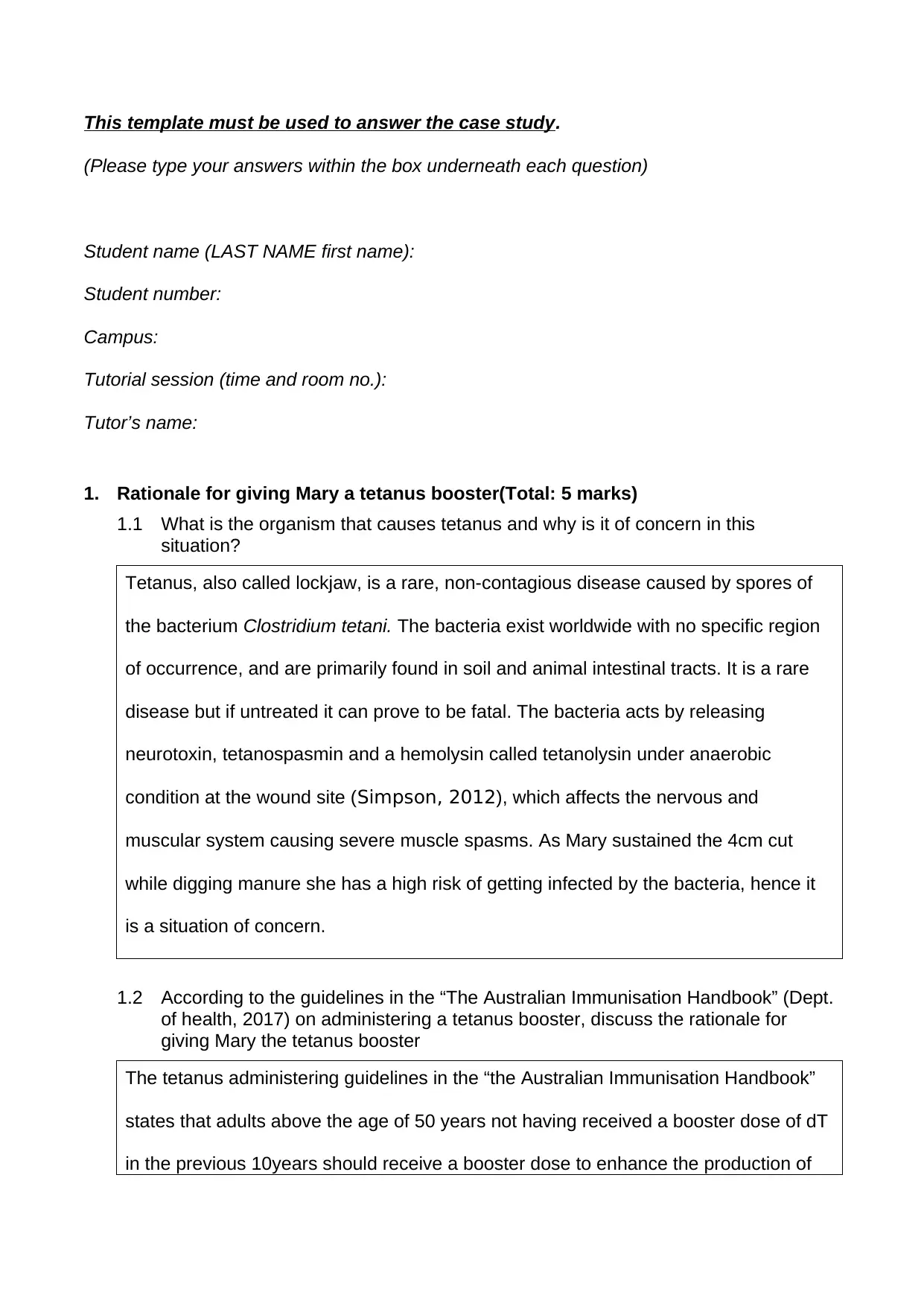
This template must be used to answer the case study.
(Please type your answers within the box underneath each question)
Student name (LAST NAME first name):
Student number:
Campus:
Tutorial session (time and room no.):
Tutor’s name:
1. Rationale for giving Mary a tetanus booster(Total: 5 marks)
1.1 What is the organism that causes tetanus and why is it of concern in this
situation?
Tetanus, also called lockjaw, is a rare, non-contagious disease caused by spores of
the bacterium Clostridium tetani. The bacteria exist worldwide with no specific region
of occurrence, and are primarily found in soil and animal intestinal tracts. It is a rare
disease but if untreated it can prove to be fatal. The bacteria acts by releasing
neurotoxin, tetanospasmin and a hemolysin called tetanolysin under anaerobic
condition at the wound site (Simpson, 2012), which affects the nervous and
muscular system causing severe muscle spasms. As Mary sustained the 4cm cut
while digging manure she has a high risk of getting infected by the bacteria, hence it
is a situation of concern.
1.2 According to the guidelines in the “The Australian Immunisation Handbook” (Dept.
of health, 2017) on administering a tetanus booster, discuss the rationale for
giving Mary the tetanus booster
The tetanus administering guidelines in the “the Australian Immunisation Handbook”
states that adults above the age of 50 years not having received a booster dose of dT
in the previous 10years should receive a booster dose to enhance the production of
(Please type your answers within the box underneath each question)
Student name (LAST NAME first name):
Student number:
Campus:
Tutorial session (time and room no.):
Tutor’s name:
1. Rationale for giving Mary a tetanus booster(Total: 5 marks)
1.1 What is the organism that causes tetanus and why is it of concern in this
situation?
Tetanus, also called lockjaw, is a rare, non-contagious disease caused by spores of
the bacterium Clostridium tetani. The bacteria exist worldwide with no specific region
of occurrence, and are primarily found in soil and animal intestinal tracts. It is a rare
disease but if untreated it can prove to be fatal. The bacteria acts by releasing
neurotoxin, tetanospasmin and a hemolysin called tetanolysin under anaerobic
condition at the wound site (Simpson, 2012), which affects the nervous and
muscular system causing severe muscle spasms. As Mary sustained the 4cm cut
while digging manure she has a high risk of getting infected by the bacteria, hence it
is a situation of concern.
1.2 According to the guidelines in the “The Australian Immunisation Handbook” (Dept.
of health, 2017) on administering a tetanus booster, discuss the rationale for
giving Mary the tetanus booster
The tetanus administering guidelines in the “the Australian Immunisation Handbook”
states that adults above the age of 50 years not having received a booster dose of dT
in the previous 10years should receive a booster dose to enhance the production of
Paraphrase This Document
Need a fresh take? Get an instant paraphrase of this document with our AI Paraphraser
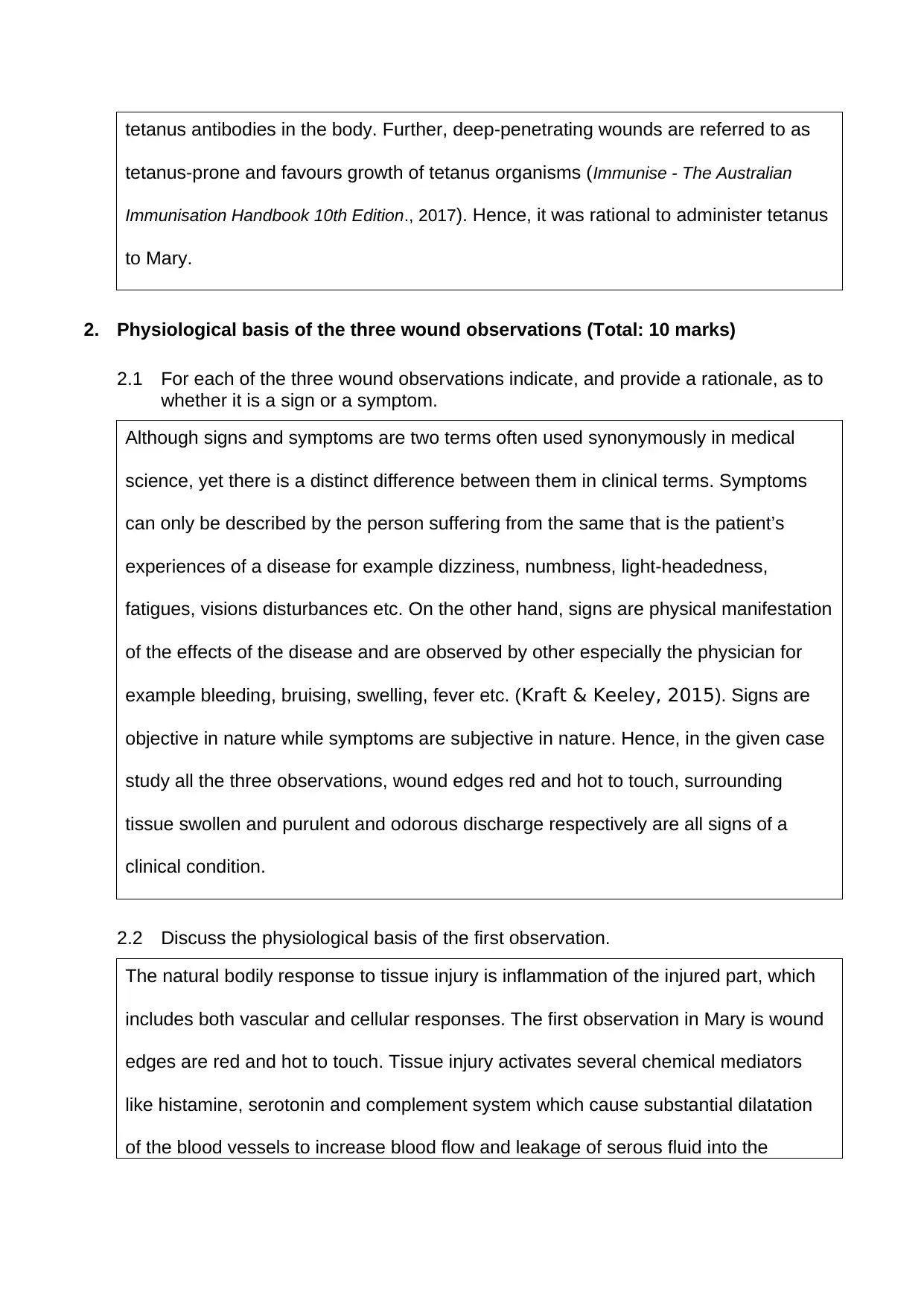
tetanus antibodies in the body. Further, deep-penetrating wounds are referred to as
tetanus-prone and favours growth of tetanus organisms (Immunise - The Australian
Immunisation Handbook 10th Edition., 2017). Hence, it was rational to administer tetanus
to Mary.
2. Physiological basis of the three wound observations (Total: 10 marks)
2.1 For each of the three wound observations indicate, and provide a rationale, as to
whether it is a sign or a symptom.
Although signs and symptoms are two terms often used synonymously in medical
science, yet there is a distinct difference between them in clinical terms. Symptoms
can only be described by the person suffering from the same that is the patient’s
experiences of a disease for example dizziness, numbness, light-headedness,
fatigues, visions disturbances etc. On the other hand, signs are physical manifestation
of the effects of the disease and are observed by other especially the physician for
example bleeding, bruising, swelling, fever etc. (Kraft & Keeley, 2015). Signs are
objective in nature while symptoms are subjective in nature. Hence, in the given case
study all the three observations, wound edges red and hot to touch, surrounding
tissue swollen and purulent and odorous discharge respectively are all signs of a
clinical condition.
2.2 Discuss the physiological basis of the first observation.
The natural bodily response to tissue injury is inflammation of the injured part, which
includes both vascular and cellular responses. The first observation in Mary is wound
edges are red and hot to touch. Tissue injury activates several chemical mediators
like histamine, serotonin and complement system which cause substantial dilatation
of the blood vessels to increase blood flow and leakage of serous fluid into the
tetanus-prone and favours growth of tetanus organisms (Immunise - The Australian
Immunisation Handbook 10th Edition., 2017). Hence, it was rational to administer tetanus
to Mary.
2. Physiological basis of the three wound observations (Total: 10 marks)
2.1 For each of the three wound observations indicate, and provide a rationale, as to
whether it is a sign or a symptom.
Although signs and symptoms are two terms often used synonymously in medical
science, yet there is a distinct difference between them in clinical terms. Symptoms
can only be described by the person suffering from the same that is the patient’s
experiences of a disease for example dizziness, numbness, light-headedness,
fatigues, visions disturbances etc. On the other hand, signs are physical manifestation
of the effects of the disease and are observed by other especially the physician for
example bleeding, bruising, swelling, fever etc. (Kraft & Keeley, 2015). Signs are
objective in nature while symptoms are subjective in nature. Hence, in the given case
study all the three observations, wound edges red and hot to touch, surrounding
tissue swollen and purulent and odorous discharge respectively are all signs of a
clinical condition.
2.2 Discuss the physiological basis of the first observation.
The natural bodily response to tissue injury is inflammation of the injured part, which
includes both vascular and cellular responses. The first observation in Mary is wound
edges are red and hot to touch. Tissue injury activates several chemical mediators
like histamine, serotonin and complement system which cause substantial dilatation
of the blood vessels to increase blood flow and leakage of serous fluid into the
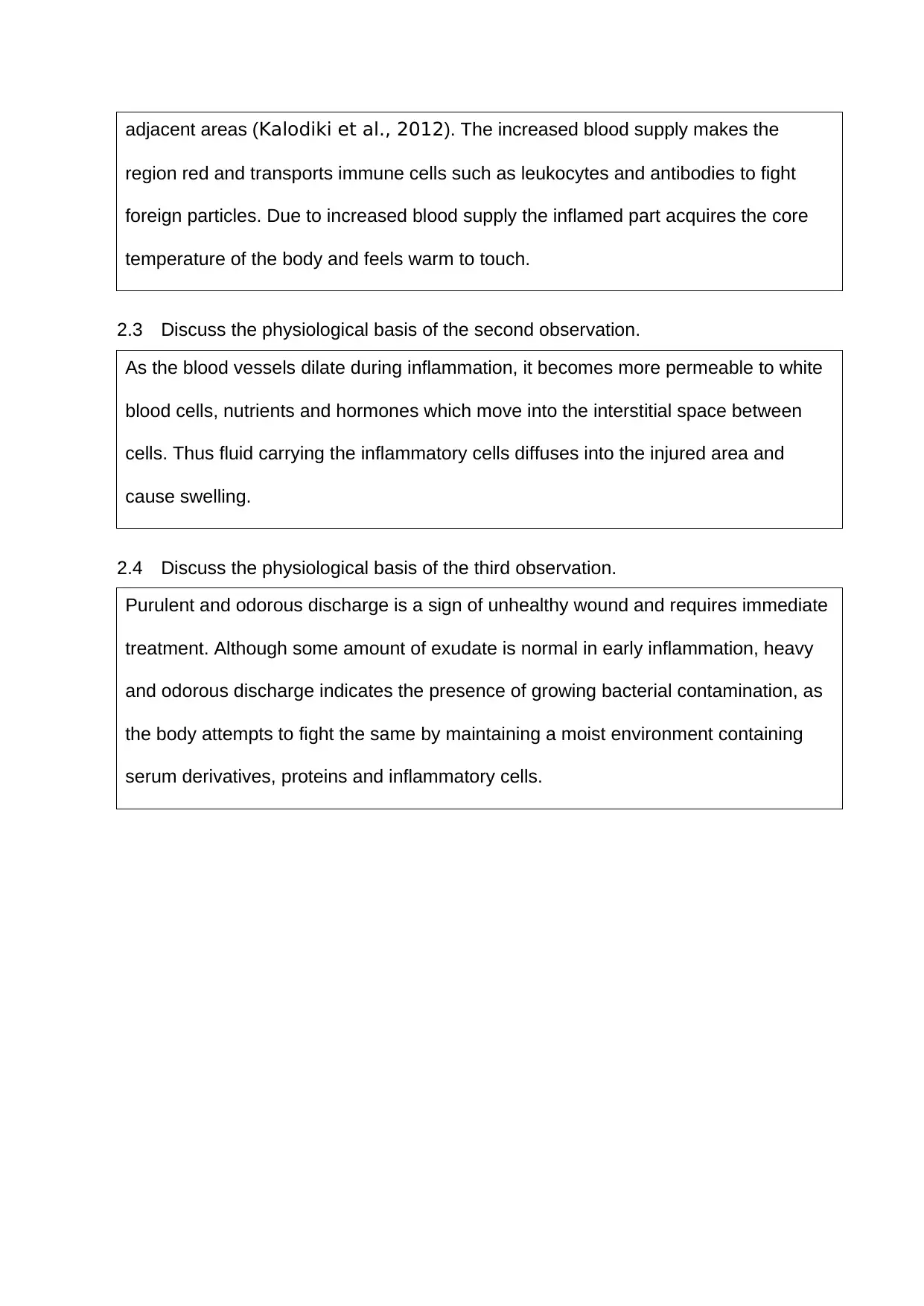
adjacent areas (Kalodiki et al., 2012). The increased blood supply makes the
region red and transports immune cells such as leukocytes and antibodies to fight
foreign particles. Due to increased blood supply the inflamed part acquires the core
temperature of the body and feels warm to touch.
2.3 Discuss the physiological basis of the second observation.
As the blood vessels dilate during inflammation, it becomes more permeable to white
blood cells, nutrients and hormones which move into the interstitial space between
cells. Thus fluid carrying the inflammatory cells diffuses into the injured area and
cause swelling.
2.4 Discuss the physiological basis of the third observation.
Purulent and odorous discharge is a sign of unhealthy wound and requires immediate
treatment. Although some amount of exudate is normal in early inflammation, heavy
and odorous discharge indicates the presence of growing bacterial contamination, as
the body attempts to fight the same by maintaining a moist environment containing
serum derivatives, proteins and inflammatory cells.
region red and transports immune cells such as leukocytes and antibodies to fight
foreign particles. Due to increased blood supply the inflamed part acquires the core
temperature of the body and feels warm to touch.
2.3 Discuss the physiological basis of the second observation.
As the blood vessels dilate during inflammation, it becomes more permeable to white
blood cells, nutrients and hormones which move into the interstitial space between
cells. Thus fluid carrying the inflammatory cells diffuses into the injured area and
cause swelling.
2.4 Discuss the physiological basis of the third observation.
Purulent and odorous discharge is a sign of unhealthy wound and requires immediate
treatment. Although some amount of exudate is normal in early inflammation, heavy
and odorous discharge indicates the presence of growing bacterial contamination, as
the body attempts to fight the same by maintaining a moist environment containing
serum derivatives, proteins and inflammatory cells.
⊘ This is a preview!⊘
Do you want full access?
Subscribe today to unlock all pages.

Trusted by 1+ million students worldwide
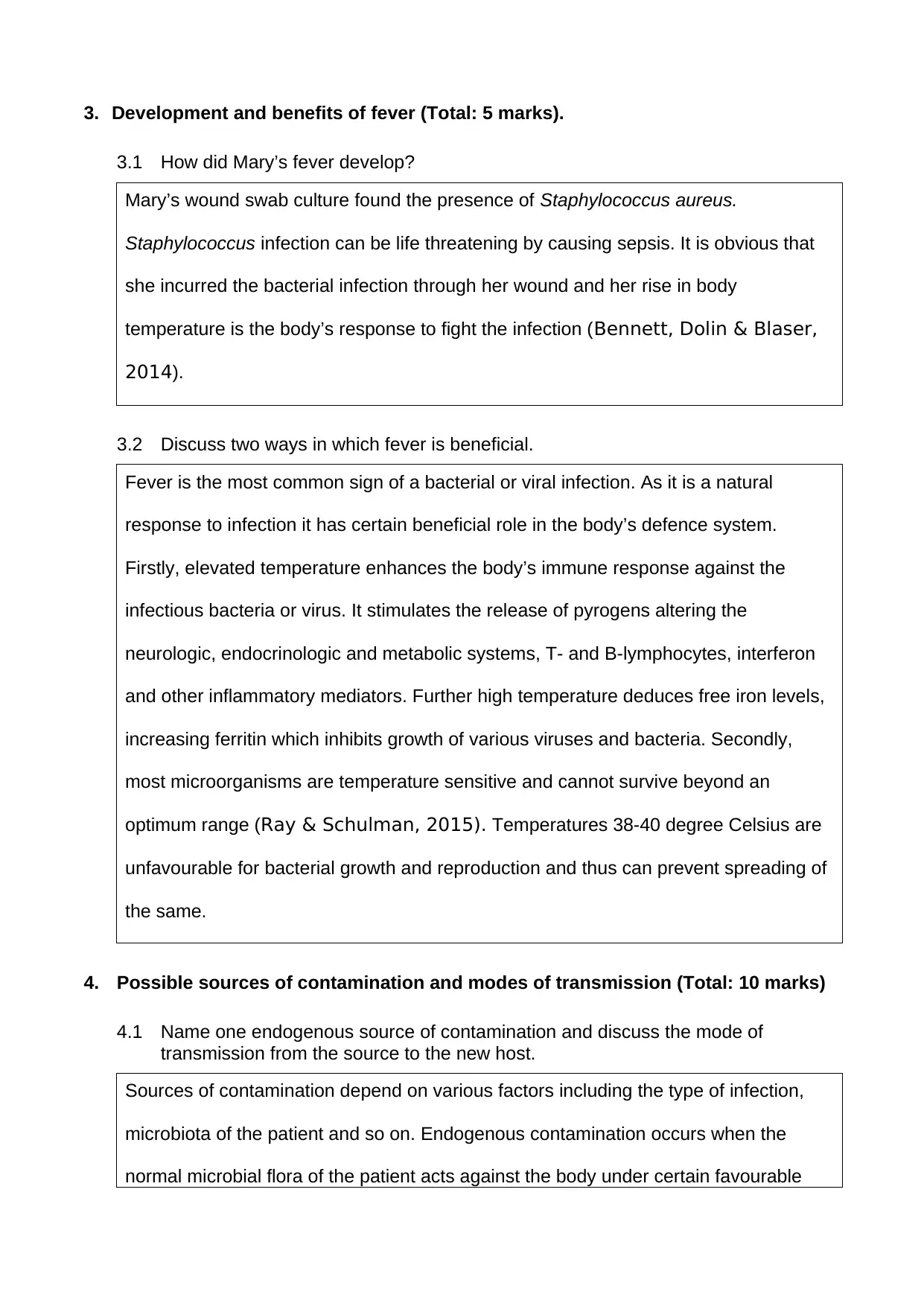
3. Development and benefits of fever (Total: 5 marks).
3.1 How did Mary’s fever develop?
Mary’s wound swab culture found the presence of Staphylococcus aureus.
Staphylococcus infection can be life threatening by causing sepsis. It is obvious that
she incurred the bacterial infection through her wound and her rise in body
temperature is the body’s response to fight the infection (Bennett, Dolin & Blaser,
2014).
3.2 Discuss two ways in which fever is beneficial.
Fever is the most common sign of a bacterial or viral infection. As it is a natural
response to infection it has certain beneficial role in the body’s defence system.
Firstly, elevated temperature enhances the body’s immune response against the
infectious bacteria or virus. It stimulates the release of pyrogens altering the
neurologic, endocrinologic and metabolic systems, T- and B-lymphocytes, interferon
and other inflammatory mediators. Further high temperature deduces free iron levels,
increasing ferritin which inhibits growth of various viruses and bacteria. Secondly,
most microorganisms are temperature sensitive and cannot survive beyond an
optimum range (Ray & Schulman, 2015). Temperatures 38-40 degree Celsius are
unfavourable for bacterial growth and reproduction and thus can prevent spreading of
the same.
4. Possible sources of contamination and modes of transmission (Total: 10 marks)
4.1 Name one endogenous source of contamination and discuss the mode of
transmission from the source to the new host.
Sources of contamination depend on various factors including the type of infection,
microbiota of the patient and so on. Endogenous contamination occurs when the
normal microbial flora of the patient acts against the body under certain favourable
3.1 How did Mary’s fever develop?
Mary’s wound swab culture found the presence of Staphylococcus aureus.
Staphylococcus infection can be life threatening by causing sepsis. It is obvious that
she incurred the bacterial infection through her wound and her rise in body
temperature is the body’s response to fight the infection (Bennett, Dolin & Blaser,
2014).
3.2 Discuss two ways in which fever is beneficial.
Fever is the most common sign of a bacterial or viral infection. As it is a natural
response to infection it has certain beneficial role in the body’s defence system.
Firstly, elevated temperature enhances the body’s immune response against the
infectious bacteria or virus. It stimulates the release of pyrogens altering the
neurologic, endocrinologic and metabolic systems, T- and B-lymphocytes, interferon
and other inflammatory mediators. Further high temperature deduces free iron levels,
increasing ferritin which inhibits growth of various viruses and bacteria. Secondly,
most microorganisms are temperature sensitive and cannot survive beyond an
optimum range (Ray & Schulman, 2015). Temperatures 38-40 degree Celsius are
unfavourable for bacterial growth and reproduction and thus can prevent spreading of
the same.
4. Possible sources of contamination and modes of transmission (Total: 10 marks)
4.1 Name one endogenous source of contamination and discuss the mode of
transmission from the source to the new host.
Sources of contamination depend on various factors including the type of infection,
microbiota of the patient and so on. Endogenous contamination occurs when the
normal microbial flora of the patient acts against the body under certain favourable
Paraphrase This Document
Need a fresh take? Get an instant paraphrase of this document with our AI Paraphraser
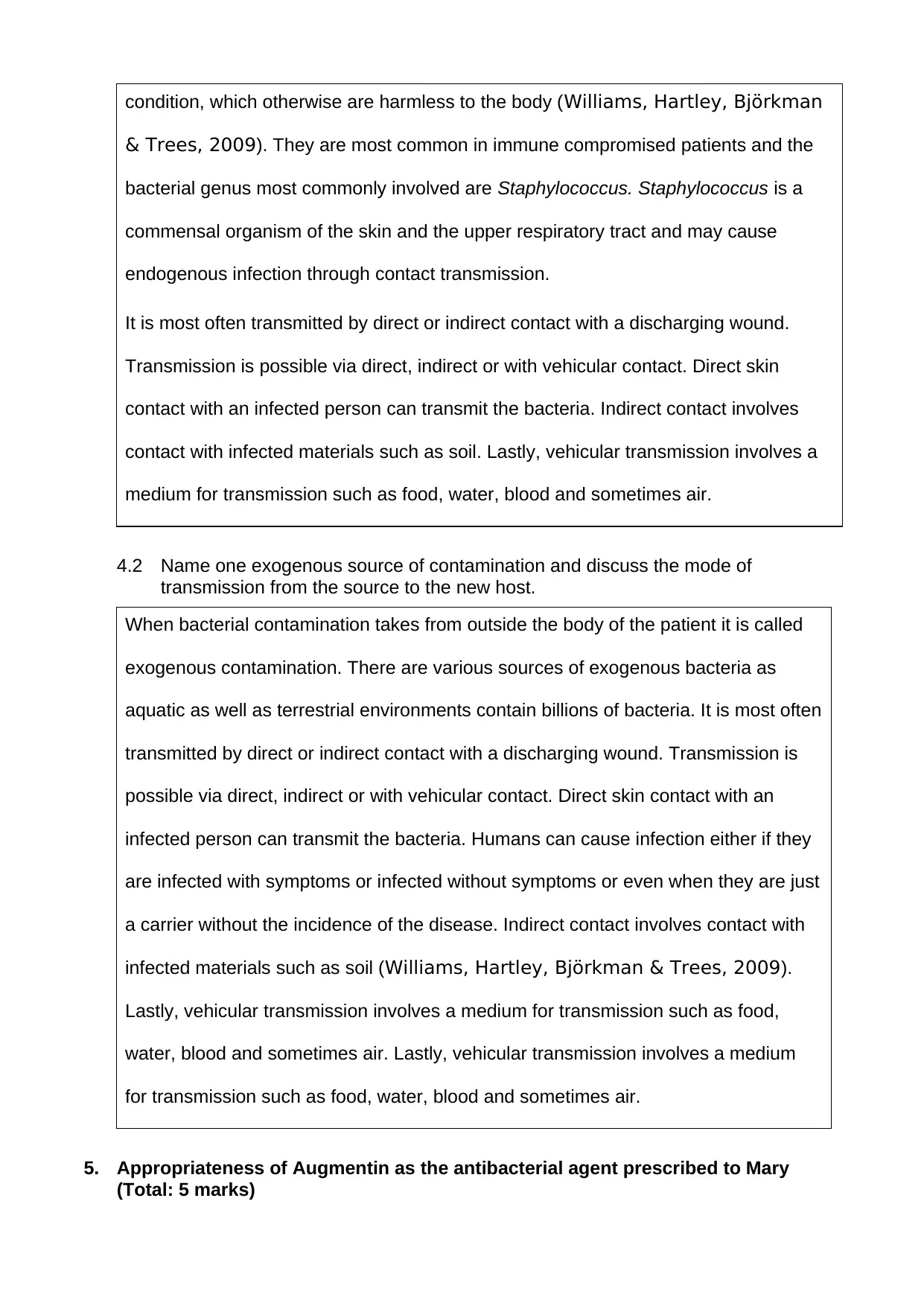
condition, which otherwise are harmless to the body (Williams, Hartley, Björkman
& Trees, 2009). They are most common in immune compromised patients and the
bacterial genus most commonly involved are Staphylococcus. Staphylococcus is a
commensal organism of the skin and the upper respiratory tract and may cause
endogenous infection through contact transmission.
It is most often transmitted by direct or indirect contact with a discharging wound.
Transmission is possible via direct, indirect or with vehicular contact. Direct skin
contact with an infected person can transmit the bacteria. Indirect contact involves
contact with infected materials such as soil. Lastly, vehicular transmission involves a
medium for transmission such as food, water, blood and sometimes air.
4.2 Name one exogenous source of contamination and discuss the mode of
transmission from the source to the new host.
When bacterial contamination takes from outside the body of the patient it is called
exogenous contamination. There are various sources of exogenous bacteria as
aquatic as well as terrestrial environments contain billions of bacteria. It is most often
transmitted by direct or indirect contact with a discharging wound. Transmission is
possible via direct, indirect or with vehicular contact. Direct skin contact with an
infected person can transmit the bacteria. Humans can cause infection either if they
are infected with symptoms or infected without symptoms or even when they are just
a carrier without the incidence of the disease. Indirect contact involves contact with
infected materials such as soil (Williams, Hartley, Björkman & Trees, 2009).
Lastly, vehicular transmission involves a medium for transmission such as food,
water, blood and sometimes air. Lastly, vehicular transmission involves a medium
for transmission such as food, water, blood and sometimes air.
5. Appropriateness of Augmentin as the antibacterial agent prescribed to Mary
(Total: 5 marks)
& Trees, 2009). They are most common in immune compromised patients and the
bacterial genus most commonly involved are Staphylococcus. Staphylococcus is a
commensal organism of the skin and the upper respiratory tract and may cause
endogenous infection through contact transmission.
It is most often transmitted by direct or indirect contact with a discharging wound.
Transmission is possible via direct, indirect or with vehicular contact. Direct skin
contact with an infected person can transmit the bacteria. Indirect contact involves
contact with infected materials such as soil. Lastly, vehicular transmission involves a
medium for transmission such as food, water, blood and sometimes air.
4.2 Name one exogenous source of contamination and discuss the mode of
transmission from the source to the new host.
When bacterial contamination takes from outside the body of the patient it is called
exogenous contamination. There are various sources of exogenous bacteria as
aquatic as well as terrestrial environments contain billions of bacteria. It is most often
transmitted by direct or indirect contact with a discharging wound. Transmission is
possible via direct, indirect or with vehicular contact. Direct skin contact with an
infected person can transmit the bacteria. Humans can cause infection either if they
are infected with symptoms or infected without symptoms or even when they are just
a carrier without the incidence of the disease. Indirect contact involves contact with
infected materials such as soil (Williams, Hartley, Björkman & Trees, 2009).
Lastly, vehicular transmission involves a medium for transmission such as food,
water, blood and sometimes air. Lastly, vehicular transmission involves a medium
for transmission such as food, water, blood and sometimes air.
5. Appropriateness of Augmentin as the antibacterial agent prescribed to Mary
(Total: 5 marks)
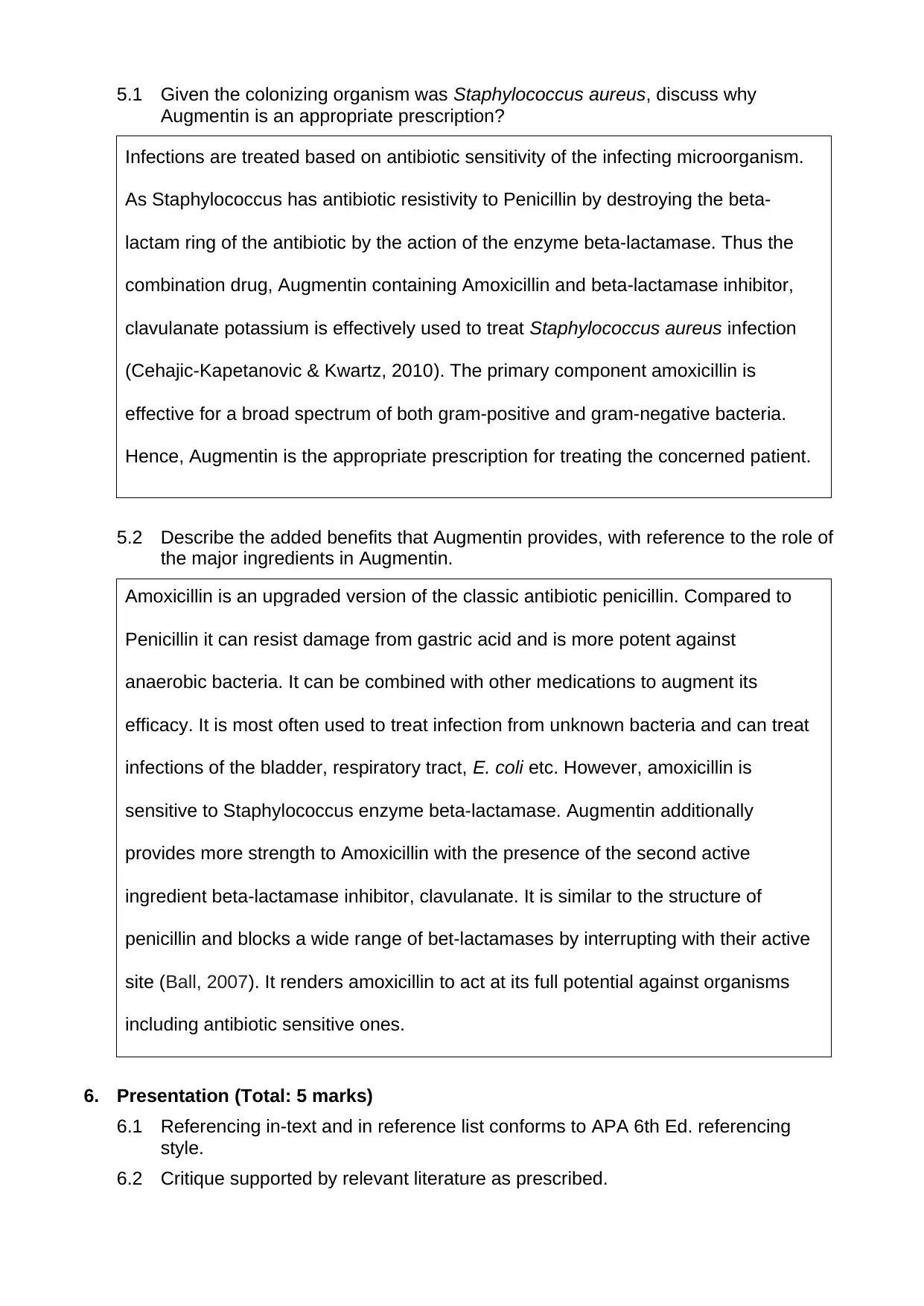
5.1 Given the colonizing organism was Staphylococcus aureus, discuss why
Augmentin is an appropriate prescription?
Infections are treated based on antibiotic sensitivity of the infecting microorganism.
As Staphylococcus has antibiotic resistivity to Penicillin by destroying the beta-
lactam ring of the antibiotic by the action of the enzyme beta-lactamase. Thus the
combination drug, Augmentin containing Amoxicillin and beta-lactamase inhibitor,
clavulanate potassium is effectively used to treat Staphylococcus aureus infection
(Cehajic-Kapetanovic & Kwartz, 2010). The primary component amoxicillin is
effective for a broad spectrum of both gram-positive and gram-negative bacteria.
Hence, Augmentin is the appropriate prescription for treating the concerned patient.
5.2 Describe the added benefits that Augmentin provides, with reference to the role of
the major ingredients in Augmentin.
Amoxicillin is an upgraded version of the classic antibiotic penicillin. Compared to
Penicillin it can resist damage from gastric acid and is more potent against
anaerobic bacteria. It can be combined with other medications to augment its
efficacy. It is most often used to treat infection from unknown bacteria and can treat
infections of the bladder, respiratory tract, E. coli etc. However, amoxicillin is
sensitive to Staphylococcus enzyme beta-lactamase. Augmentin additionally
provides more strength to Amoxicillin with the presence of the second active
ingredient beta-lactamase inhibitor, clavulanate. It is similar to the structure of
penicillin and blocks a wide range of bet-lactamases by interrupting with their active
site (Ball, 2007). It renders amoxicillin to act at its full potential against organisms
including antibiotic sensitive ones.
6. Presentation (Total: 5 marks)
6.1 Referencing in-text and in reference list conforms to APA 6th Ed. referencing
style.
6.2 Critique supported by relevant literature as prescribed.
Augmentin is an appropriate prescription?
Infections are treated based on antibiotic sensitivity of the infecting microorganism.
As Staphylococcus has antibiotic resistivity to Penicillin by destroying the beta-
lactam ring of the antibiotic by the action of the enzyme beta-lactamase. Thus the
combination drug, Augmentin containing Amoxicillin and beta-lactamase inhibitor,
clavulanate potassium is effectively used to treat Staphylococcus aureus infection
(Cehajic-Kapetanovic & Kwartz, 2010). The primary component amoxicillin is
effective for a broad spectrum of both gram-positive and gram-negative bacteria.
Hence, Augmentin is the appropriate prescription for treating the concerned patient.
5.2 Describe the added benefits that Augmentin provides, with reference to the role of
the major ingredients in Augmentin.
Amoxicillin is an upgraded version of the classic antibiotic penicillin. Compared to
Penicillin it can resist damage from gastric acid and is more potent against
anaerobic bacteria. It can be combined with other medications to augment its
efficacy. It is most often used to treat infection from unknown bacteria and can treat
infections of the bladder, respiratory tract, E. coli etc. However, amoxicillin is
sensitive to Staphylococcus enzyme beta-lactamase. Augmentin additionally
provides more strength to Amoxicillin with the presence of the second active
ingredient beta-lactamase inhibitor, clavulanate. It is similar to the structure of
penicillin and blocks a wide range of bet-lactamases by interrupting with their active
site (Ball, 2007). It renders amoxicillin to act at its full potential against organisms
including antibiotic sensitive ones.
6. Presentation (Total: 5 marks)
6.1 Referencing in-text and in reference list conforms to APA 6th Ed. referencing
style.
6.2 Critique supported by relevant literature as prescribed.
⊘ This is a preview!⊘
Do you want full access?
Subscribe today to unlock all pages.

Trusted by 1+ million students worldwide
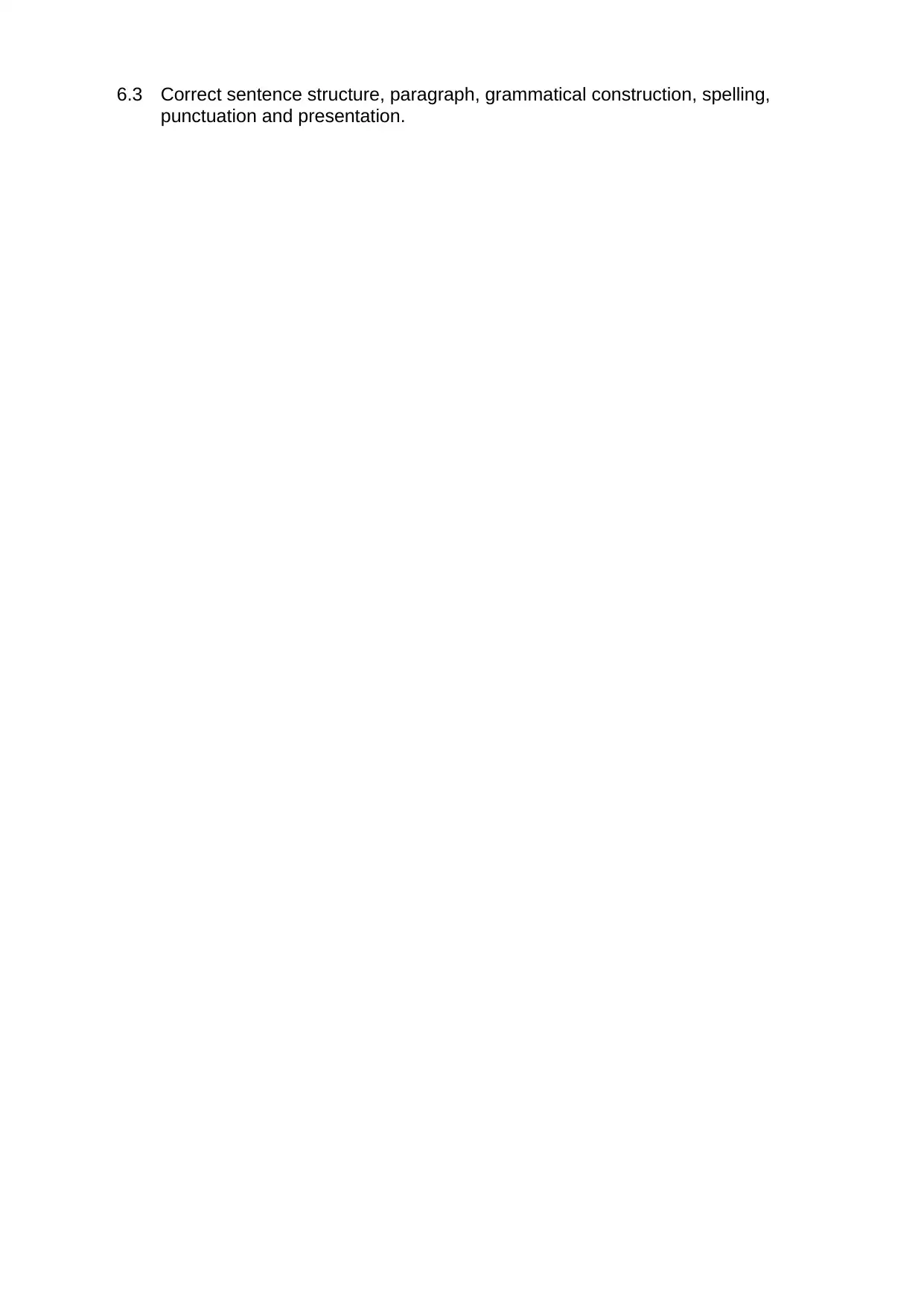
6.3 Correct sentence structure, paragraph, grammatical construction, spelling,
punctuation and presentation.
punctuation and presentation.
1 out of 7
Related Documents
Your All-in-One AI-Powered Toolkit for Academic Success.
+13062052269
info@desklib.com
Available 24*7 on WhatsApp / Email
![[object Object]](/_next/static/media/star-bottom.7253800d.svg)
Unlock your academic potential
Copyright © 2020–2025 A2Z Services. All Rights Reserved. Developed and managed by ZUCOL.





